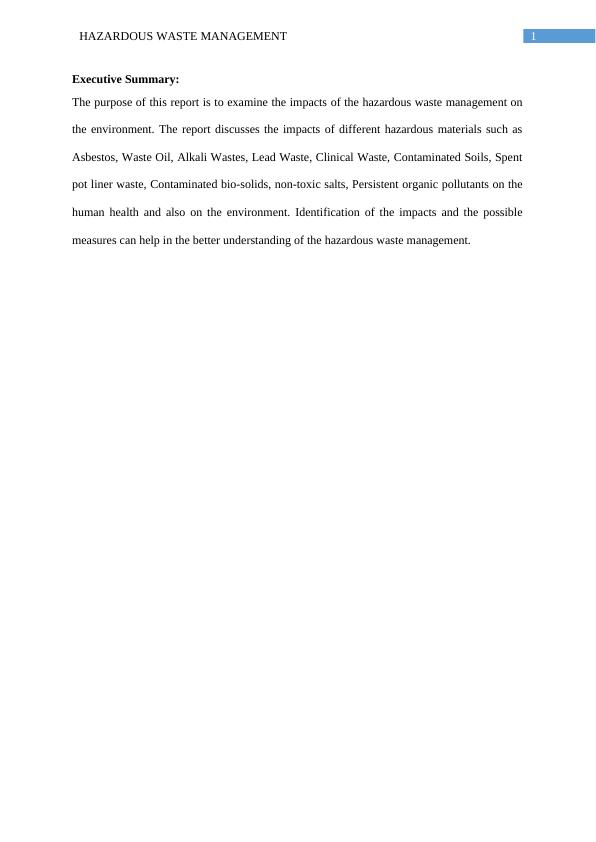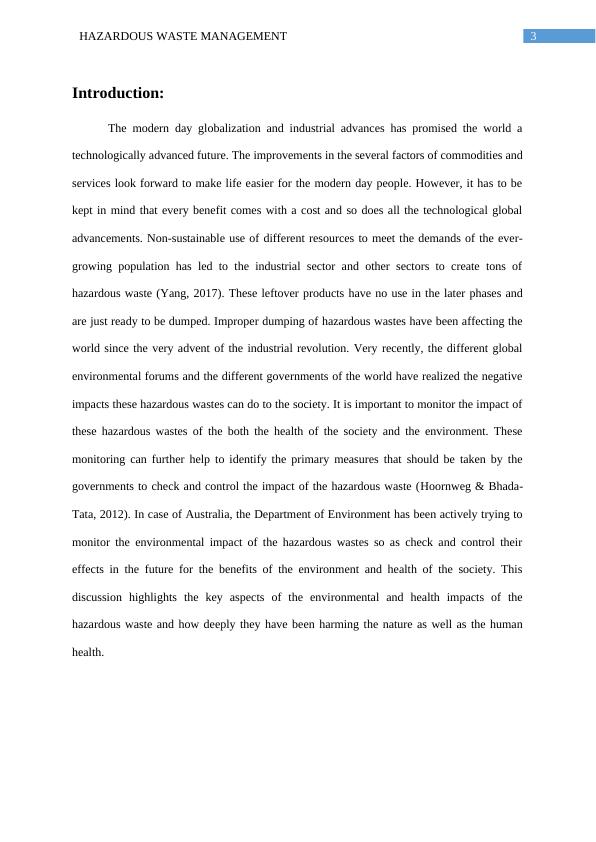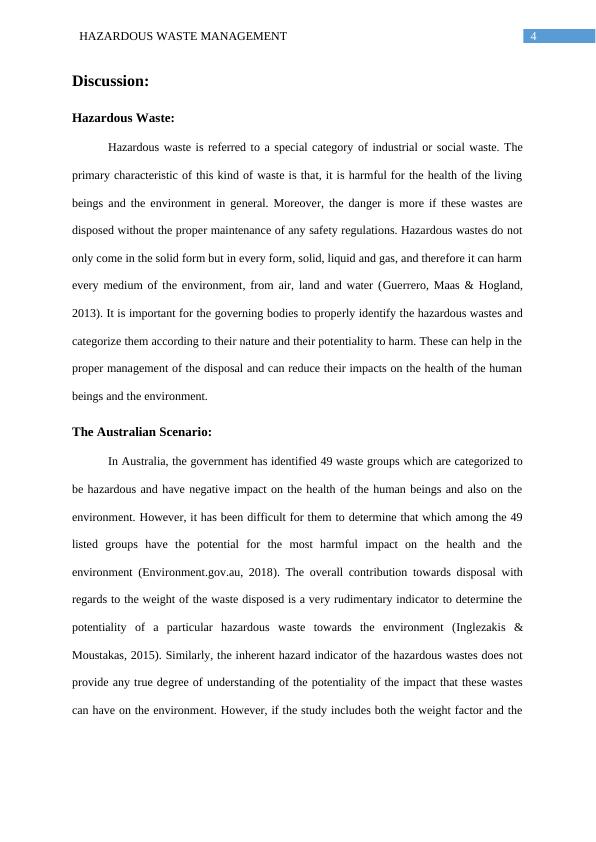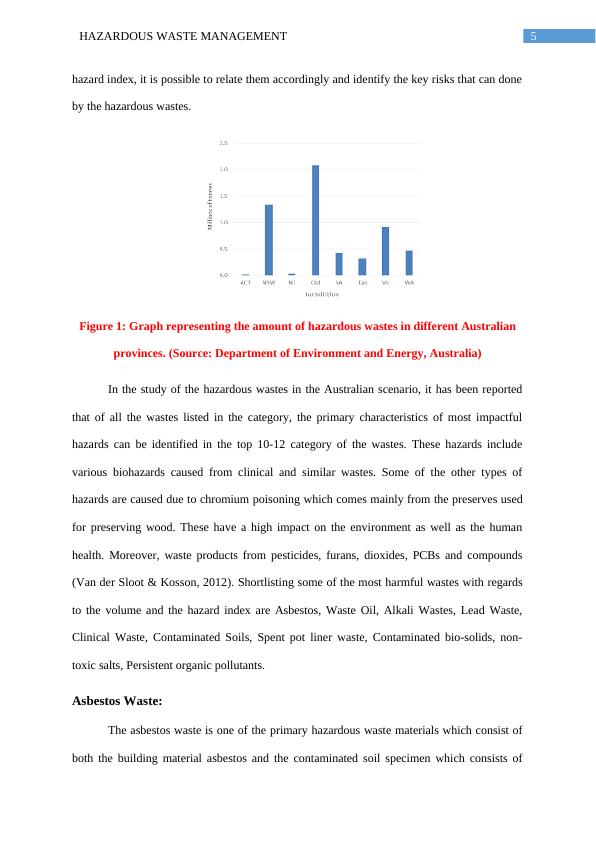Impacts of Hazardous Waste Management on Environment and Health
Added on 2023-06-07
22 Pages5901 Words229 Views
Running head: HAZARDOUS WASTE MANAGEMENT
HAZARDOUS WASTE MANAGEMENT
Name of Student
Name of University
Author note
HAZARDOUS WASTE MANAGEMENT
Name of Student
Name of University
Author note

1HAZARDOUS WASTE MANAGEMENT
Executive Summary:
The purpose of this report is to examine the impacts of the hazardous waste management on
the environment. The report discusses the impacts of different hazardous materials such as
Asbestos, Waste Oil, Alkali Wastes, Lead Waste, Clinical Waste, Contaminated Soils, Spent
pot liner waste, Contaminated bio-solids, non-toxic salts, Persistent organic pollutants on the
human health and also on the environment. Identification of the impacts and the possible
measures can help in the better understanding of the hazardous waste management.
Executive Summary:
The purpose of this report is to examine the impacts of the hazardous waste management on
the environment. The report discusses the impacts of different hazardous materials such as
Asbestos, Waste Oil, Alkali Wastes, Lead Waste, Clinical Waste, Contaminated Soils, Spent
pot liner waste, Contaminated bio-solids, non-toxic salts, Persistent organic pollutants on the
human health and also on the environment. Identification of the impacts and the possible
measures can help in the better understanding of the hazardous waste management.

2HAZARDOUS WASTE MANAGEMENT
Table of Contents
Introduction:...............................................................................................................................4
Discussion:.................................................................................................................................4
Hazardous Waste:...................................................................................................................4
The Australian Scenario:........................................................................................................5
Asbestos Waste:.....................................................................................................................6
Waste Oils:.............................................................................................................................7
Alkali Wastes:........................................................................................................................8
Lead Wastes:..........................................................................................................................9
Clinical waste:......................................................................................................................10
Contaminated Soils:.............................................................................................................11
Invisible wastes:...................................................................................................................12
Spent pot liner (SPL):...........................................................................................................12
Contaminated bio-solids:.....................................................................................................13
Coal Seam Gas waste:..........................................................................................................14
Persistent Organic Pollutants (POP):...................................................................................15
Conclusion:..............................................................................................................................15
References:...............................................................................................................................17
Table of Contents
Introduction:...............................................................................................................................4
Discussion:.................................................................................................................................4
Hazardous Waste:...................................................................................................................4
The Australian Scenario:........................................................................................................5
Asbestos Waste:.....................................................................................................................6
Waste Oils:.............................................................................................................................7
Alkali Wastes:........................................................................................................................8
Lead Wastes:..........................................................................................................................9
Clinical waste:......................................................................................................................10
Contaminated Soils:.............................................................................................................11
Invisible wastes:...................................................................................................................12
Spent pot liner (SPL):...........................................................................................................12
Contaminated bio-solids:.....................................................................................................13
Coal Seam Gas waste:..........................................................................................................14
Persistent Organic Pollutants (POP):...................................................................................15
Conclusion:..............................................................................................................................15
References:...............................................................................................................................17

3HAZARDOUS WASTE MANAGEMENT
Introduction:
The modern day globalization and industrial advances has promised the world a
technologically advanced future. The improvements in the several factors of commodities and
services look forward to make life easier for the modern day people. However, it has to be
kept in mind that every benefit comes with a cost and so does all the technological global
advancements. Non-sustainable use of different resources to meet the demands of the ever-
growing population has led to the industrial sector and other sectors to create tons of
hazardous waste (Yang, 2017). These leftover products have no use in the later phases and
are just ready to be dumped. Improper dumping of hazardous wastes have been affecting the
world since the very advent of the industrial revolution. Very recently, the different global
environmental forums and the different governments of the world have realized the negative
impacts these hazardous wastes can do to the society. It is important to monitor the impact of
these hazardous wastes of the both the health of the society and the environment. These
monitoring can further help to identify the primary measures that should be taken by the
governments to check and control the impact of the hazardous waste (Hoornweg & Bhada-
Tata, 2012). In case of Australia, the Department of Environment has been actively trying to
monitor the environmental impact of the hazardous wastes so as check and control their
effects in the future for the benefits of the environment and health of the society. This
discussion highlights the key aspects of the environmental and health impacts of the
hazardous waste and how deeply they have been harming the nature as well as the human
health.
Introduction:
The modern day globalization and industrial advances has promised the world a
technologically advanced future. The improvements in the several factors of commodities and
services look forward to make life easier for the modern day people. However, it has to be
kept in mind that every benefit comes with a cost and so does all the technological global
advancements. Non-sustainable use of different resources to meet the demands of the ever-
growing population has led to the industrial sector and other sectors to create tons of
hazardous waste (Yang, 2017). These leftover products have no use in the later phases and
are just ready to be dumped. Improper dumping of hazardous wastes have been affecting the
world since the very advent of the industrial revolution. Very recently, the different global
environmental forums and the different governments of the world have realized the negative
impacts these hazardous wastes can do to the society. It is important to monitor the impact of
these hazardous wastes of the both the health of the society and the environment. These
monitoring can further help to identify the primary measures that should be taken by the
governments to check and control the impact of the hazardous waste (Hoornweg & Bhada-
Tata, 2012). In case of Australia, the Department of Environment has been actively trying to
monitor the environmental impact of the hazardous wastes so as check and control their
effects in the future for the benefits of the environment and health of the society. This
discussion highlights the key aspects of the environmental and health impacts of the
hazardous waste and how deeply they have been harming the nature as well as the human
health.

4HAZARDOUS WASTE MANAGEMENT
Discussion:
Hazardous Waste:
Hazardous waste is referred to a special category of industrial or social waste. The
primary characteristic of this kind of waste is that, it is harmful for the health of the living
beings and the environment in general. Moreover, the danger is more if these wastes are
disposed without the proper maintenance of any safety regulations. Hazardous wastes do not
only come in the solid form but in every form, solid, liquid and gas, and therefore it can harm
every medium of the environment, from air, land and water (Guerrero, Maas & Hogland,
2013). It is important for the governing bodies to properly identify the hazardous wastes and
categorize them according to their nature and their potentiality to harm. These can help in the
proper management of the disposal and can reduce their impacts on the health of the human
beings and the environment.
The Australian Scenario:
In Australia, the government has identified 49 waste groups which are categorized to
be hazardous and have negative impact on the health of the human beings and also on the
environment. However, it has been difficult for them to determine that which among the 49
listed groups have the potential for the most harmful impact on the health and the
environment (Environment.gov.au, 2018). The overall contribution towards disposal with
regards to the weight of the waste disposed is a very rudimentary indicator to determine the
potentiality of a particular hazardous waste towards the environment (Inglezakis &
Moustakas, 2015). Similarly, the inherent hazard indicator of the hazardous wastes does not
provide any true degree of understanding of the potentiality of the impact that these wastes
can have on the environment. However, if the study includes both the weight factor and the
Discussion:
Hazardous Waste:
Hazardous waste is referred to a special category of industrial or social waste. The
primary characteristic of this kind of waste is that, it is harmful for the health of the living
beings and the environment in general. Moreover, the danger is more if these wastes are
disposed without the proper maintenance of any safety regulations. Hazardous wastes do not
only come in the solid form but in every form, solid, liquid and gas, and therefore it can harm
every medium of the environment, from air, land and water (Guerrero, Maas & Hogland,
2013). It is important for the governing bodies to properly identify the hazardous wastes and
categorize them according to their nature and their potentiality to harm. These can help in the
proper management of the disposal and can reduce their impacts on the health of the human
beings and the environment.
The Australian Scenario:
In Australia, the government has identified 49 waste groups which are categorized to
be hazardous and have negative impact on the health of the human beings and also on the
environment. However, it has been difficult for them to determine that which among the 49
listed groups have the potential for the most harmful impact on the health and the
environment (Environment.gov.au, 2018). The overall contribution towards disposal with
regards to the weight of the waste disposed is a very rudimentary indicator to determine the
potentiality of a particular hazardous waste towards the environment (Inglezakis &
Moustakas, 2015). Similarly, the inherent hazard indicator of the hazardous wastes does not
provide any true degree of understanding of the potentiality of the impact that these wastes
can have on the environment. However, if the study includes both the weight factor and the

5HAZARDOUS WASTE MANAGEMENT
hazard index, it is possible to relate them accordingly and identify the key risks that can done
by the hazardous wastes.
Figure 1: Graph representing the amount of hazardous wastes in different Australian
provinces. (Source: Department of Environment and Energy, Australia)
In the study of the hazardous wastes in the Australian scenario, it has been reported
that of all the wastes listed in the category, the primary characteristics of most impactful
hazards can be identified in the top 10-12 category of the wastes. These hazards include
various biohazards caused from clinical and similar wastes. Some of the other types of
hazards are caused due to chromium poisoning which comes mainly from the preserves used
for preserving wood. These have a high impact on the environment as well as the human
health. Moreover, waste products from pesticides, furans, dioxides, PCBs and compounds
(Van der Sloot & Kosson, 2012). Shortlisting some of the most harmful wastes with regards
to the volume and the hazard index are Asbestos, Waste Oil, Alkali Wastes, Lead Waste,
Clinical Waste, Contaminated Soils, Spent pot liner waste, Contaminated bio-solids, non-
toxic salts, Persistent organic pollutants.
Asbestos Waste:
The asbestos waste is one of the primary hazardous waste materials which consist of
both the building material asbestos and the contaminated soil specimen which consists of
hazard index, it is possible to relate them accordingly and identify the key risks that can done
by the hazardous wastes.
Figure 1: Graph representing the amount of hazardous wastes in different Australian
provinces. (Source: Department of Environment and Energy, Australia)
In the study of the hazardous wastes in the Australian scenario, it has been reported
that of all the wastes listed in the category, the primary characteristics of most impactful
hazards can be identified in the top 10-12 category of the wastes. These hazards include
various biohazards caused from clinical and similar wastes. Some of the other types of
hazards are caused due to chromium poisoning which comes mainly from the preserves used
for preserving wood. These have a high impact on the environment as well as the human
health. Moreover, waste products from pesticides, furans, dioxides, PCBs and compounds
(Van der Sloot & Kosson, 2012). Shortlisting some of the most harmful wastes with regards
to the volume and the hazard index are Asbestos, Waste Oil, Alkali Wastes, Lead Waste,
Clinical Waste, Contaminated Soils, Spent pot liner waste, Contaminated bio-solids, non-
toxic salts, Persistent organic pollutants.
Asbestos Waste:
The asbestos waste is one of the primary hazardous waste materials which consist of
both the building material asbestos and the contaminated soil specimen which consists of

End of preview
Want to access all the pages? Upload your documents or become a member.
Related Documents
Environmental and Health Impacts of Hazardous Wasteslg...
|24
|6678
|88
Landfill Hazards and Innovative Technologylg...
|8
|2107
|65
Solid Waste Management: Methods and Effectslg...
|12
|924
|263
Environmental Impacts of Gold Ore Mining in Australialg...
|13
|2908
|250
Toxicologylg...
|10
|2408
|280
Human Impact On The Environmentlg...
|9
|2023
|17
